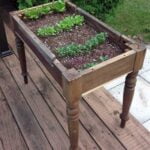Are you looking for fresh ideas for square gardens? Gardening in a square-shaped space presents unique challenges and opportunities that can be explored and celebrated. Proper planning and design are essential for making the most of this specific layout, allowing you to create a stunning outdoor oasis. In this article, we will delve into various aspects of gardening in a square space, offering tips and ideas to help you maximize its potential.
When it comes to square gardens, maximizing space is key. Innovative vertical garden designs can make the most of limited square footage, creating a lush and vibrant environment. From trellises and wall-mounted planters to hanging baskets, there are numerous ways to utilize vertical space effectively. We’ll explore these techniques and offer practical ideas for incorporating them into your square garden.
Creating symmetry in square gardens is another important aspect to consider. By pairing plants in an intentional and balanced way, you can enhance the overall visual appeal of your garden. We’ll discuss how to achieve symmetry and offer suggestions for complementary plant combinations that work well in square-shaped layouts. With our tips, you can create a harmonious and visually stunning garden that embraces the concept of balance and proportion.
Maximizing Space
When it comes to square gardens, space can often be a premium. However, by thinking vertically, gardeners can make the most of their square plot and create a lush and beautiful garden. Vertical gardening techniques such as trellises, wall-mounted planters, and hanging baskets offer unique opportunities for maximizing space while adding visual interest to the garden.
One idea for square gardens is to utilize trellises to grow climbing plants such as vines, flowers, or vegetables. By training these plants to grow vertically, gardeners can take advantage of the vertical space in their square garden and create a stunning display. Additionally, wall-mounted planters are an excellent way to add greenery to any available wall space. These planters not only add visual interest but also allow for more planting area without taking up valuable ground space.
Another way to maximize space in a square garden is by using hanging baskets. These baskets can be filled with trailing plants or colorful flowers, adding depth and dimension to the garden while leaving valuable ground space open for other features or planting areas.
| Vertical Gardening Techniques | Benefits |
|---|---|
| Trellises | Take advantage of vertical space and create stunning displays |
| Wall-Mounted Planters | Add visual interest and more planting area without taking up ground space |
| Hanging Baskets | Add depth and dimension while leaving ground space open for other features or planting areas |
Perfect Plant Pairings
Creating symmetry in a square garden is essential for achieving a balanced and harmonious look. When it comes to plant pairings, there are several approaches to consider in order to create visually appealing and cohesive arrangements. One popular technique is to use complementary plants that work well together in terms of color, texture, and height.
For example, you can create symmetry by planting tall, spiky plants at the back of the garden bed and shorter, bushier plants in the front. This layering effect not only adds visual interest but also allows each plant to be showcased effectively. Additionally, you can create symmetry by using plants with similar leaf shapes or flower colors on opposite sides of the garden.
When choosing plants for your square garden, it’s important to consider their growth habits and maintenance requirements. It’s best to select plant pairings that have similar care needs in terms of sunlight, water, and soil conditions. This will make it easier to maintain the overall health and appearance of the garden.
In order to enhance the symmetry of your plant pairings, you can also incorporate other design elements such as pathways or borders that help define different sections of the garden. By carefully planning and selecting plant combinations that complement each other, you can create a sense of harmony and balance in your square garden.
| Plant Pairing Technique | Example |
|---|---|
| Layering based on height | Planting tall spiky plants at the back and shorter bushier plants in the front |
| Similar leaf shapes or flower colors on opposite sides | Using plants with similar features on either side for visual symmetry |
Focal Points
Adding visual interest to your square garden is essential for creating a dynamic and inviting outdoor space. One effective way to achieve this is by incorporating focal points throughout the garden. These focal points serve as eye-catching features that draw attention and add a sense of intrigue to the overall design. There are several creative ideas for incorporating focal points in square gardens that can elevate the visual appeal of your outdoor oasis.
One popular way to create a focal point in a square garden is by introducing unique plant containers or sculptures. These can range from ornate, decorative pots to modern, minimalist planters, depending on your personal style and the aesthetic of your garden. Additionally, strategically placing statues or art installations amidst the greenery can provide a striking focal point that captures attention and adds character to the space.
Another idea for adding visual interest to your square garden is by incorporating water features such as fountains, ponds, or waterfalls. Not only do these elements create a soothing atmosphere with the gentle sound of running water, but they also serve as captivating focal points that can transform an ordinary garden into a tranquil retreat.
In addition to plant containers and water features, architectural elements like trellises or arbors can be used as focal points in a square garden. These structures not only provide support for climbing plants but also add height and dimension to the space while serving as visually appealing anchors within the garden layout. By strategically placing these elements throughout your square garden, you can create an engaging and aesthetically pleasing environment that enhances the overall beauty of your outdoor space.
Seasonal Planning
When planning a square garden, it’s essential to consider how the space will look throughout the year. With proper seasonal planning, you can ensure that your garden maintains visual appeal no matter the season. Here are some tips for creating year-round beauty in your square garden:
1. Select a Variety of Plants: Choose a mix of plants that provide interest in different seasons. Consider including flowering shrubs for spring, evergreen trees for winter, and seasonal bulbs for a pop of color in the summer or fall.
2. Incorporate Evergreen Plants: Evergreens are an excellent addition to square gardens as they provide structure and color year-round. Look for varieties that offer different textures and shades to add visual interest to your garden.
3. Plan for Succession Planting: To keep your garden looking vibrant throughout the year, plan for succession planting. This involves planting new crops as soon as old ones are harvested, ensuring that there is always something growing in your garden.
By carefully selecting plants and planning the layout of your square garden, you can create a visually appealing space that thrives throughout the year. With thoughtful consideration of seasonal changes, you can design a garden that offers something beautiful to see no matter the time of year.
Remember that maintaining year-round beauty in your square garden requires ongoing care and attention. Regular watering, fertilization, and pruning are essential to keeping your garden healthy and vibrant regardless of the season. By embracing seasonal planning and following maintenance tips, you can create a stunning square garden that captivates throughout the year.
Paths and Borders
When designing a square garden, creating defined paths and borders is essential to provide structure and organization to the space. Paths allow for easy access and movement throughout the garden, while borders help delineate different planting areas and add visual interest. Here are some ideas for incorporating paths and borders into your square garden:
1. Paving Stones: One way to create paths in a square garden is by using paving stones. These can be arranged in various patterns such as herringbone or basket weave to add texture and visual appeal. Paving stones also come in a variety of colors, allowing you to coordinate them with the overall color scheme of your garden.
2. Gravel Paths: For a more rustic or natural look, consider using gravel for your garden paths. Gravel is low-maintenance and provides good drainage, making it an ideal choice for pathways in a square garden. You can use different sizes and colors of gravel to create unique designs that complement the style of your garden.
3. Low Hedges: In addition to defining paths, borders can also be created using low hedges or shrubs. These plants not only serve as a boundary between different planting areas but also add greenery and structure to the garden. Boxwood, Japanese holly, or lavender are excellent choices for creating formal or informal borders in a square garden.
4. Garden Edging: Another way to create borders in your square garden is by using garden edging materials such as timber, metal, or plastic. These edging materials can be used to outline flower beds, vegetable patches, or other specific areas within the garden, adding a neat and tidy appearance.
By integrating well-planned paths and borders into your square garden design, you can create an organized and visually appealing outdoor space that maximizes both form and function.
The Concept of Utilizing Proper Pathways Adds Functionality
While Incorporating Well-Designed Edges Establishes Boundaries
to exude elegance within one’s personalized square-shaped layout.
Color Theory
Principles of Color Theory
Understanding the principles of color theory is essential for creating a visually appealing square garden. The color wheel serves as a valuable tool for understanding how colors work together. Analogous colors, which are next to each other on the color wheel, create a harmonious and calming effect when used together.
On the other hand, complementary colors, which are opposite each other on the color wheel, create a dynamic and vibrant contrast when paired together in a garden. Triadic color schemes, which consist of three colors equally spaced apart on the color wheel, provide an opportunity to add variety and interest to a square garden.
Cohesive Color Schemes
When planning a square garden, it’s important to consider the overall color scheme to ensure cohesion and harmony. A monochromatic color scheme features different shades and tints of one color and can create a feeling of serenity and simplicity in a square garden.
A analogous color scheme using hues that are next to each other on the color wheel creates a soothing and unified look in the garden. Combining different textures and leaf shapes within the chosen color scheme can further enhance visual interest in a square garden design.
Creating Depth and Dimension
Using color strategically can help create depth and dimension in a square garden. Darker colors tend to recede visually while lighter colors appear closer, so placing darker plants towards the back of the square garden can give the illusion of depth.
Incorporating warm colors like reds, oranges, and yellows in the front of the garden draws attention and adds energy to space. Additionally, utilizing cool colors like blues and purples towards the back of the garden creates a sense of calmness and serenity.
By understanding these principles of color theory, you can effectively use color to enhance your square garden design, creating an inviting and visually appealing outdoor space that delights throughout the seasons.
Maintenance Tips
Keeping a square garden healthy and vibrant requires ongoing maintenance and care. Proper watering, fertilization, and pruning are essential to ensure that the plants thrive and the garden maintains its visual appeal throughout the year. Here are some practical maintenance tips to help you keep your square garden in top condition.
Proper Watering
One of the most important aspects of maintaining a healthy square garden is proper watering. Different plants have different water requirements, so it’s essential to understand the needs of each type of plant in your garden. Consider installing a drip irrigation system to ensure that each plant receives the right amount of water, or use a soaker hose for efficient and targeted watering.
Fertilization
Fertilizing your square garden is crucial for providing essential nutrients to the soil and promoting healthy growth. Choose a balanced fertilizer that includes nitrogen, phosphorus, and potassium to support strong root development and vibrant foliage. It’s also essential to follow the recommended schedule for fertilizing each type of plant in your garden to avoid over-fertilization or nutrient deficiencies.
Pruning
Regular pruning is necessary to maintain the shape and health of plants in your square garden. Prune away dead or damaged branches to encourage new growth and improve overall plant health. Additionally, shaping shrubs and hedges will help maintain the structure and symmetry of your garden design. Be sure to use clean, sharp tools for pruning to avoid causing unnecessary stress or injury to the plants.
By following these maintenance tips, you can ensure that your square garden remains healthy and vibrant throughout the year, allowing you to enjoy its beauty day after day.
Conclusion
In conclusion, the possibilities for square gardens are truly endless. With careful planning and innovative design, gardeners can transform these unique spaces into stunning outdoor retreats. By maximizing vertical space, creating balanced plant pairings, incorporating focal points, planning for year-round beauty, defining paths and borders, utilizing color theory, and maintaining proper care, square gardens can become a source of pride and joy for their owners.
As we wrap up this exploration of square gardens, it’s important to remember that the key to success lies in embracing the distinctive challenges and opportunities that come with gardening in a square-shaped space. Whether you’re working with a small urban patio or a larger suburban yard, the principles outlined here can be applied to create visually captivating and harmonious square gardens.
We encourage our readers to share their own experiences and ideas for square gardens. Your creativity and insights could inspire others to embark on their own square garden projects and contribute to the vibrant community of garden enthusiasts. Together, let’s continue to celebrate the beauty and potential of square gardens as we cultivate our own green oases.
Frequently Asked Questions
What Can I Do With a Square Garden?
A square garden offers a lot of possibilities for landscaping and planting. You can create different sections for flowers, vegetables, herbs, or even install a small fountain or seating area in the center to make it a relaxing space.
How Do You Break Up a Square Garden?
Breaking up a square garden can be done by using landscaping techniques such as creating curved pathways, adding raised flower beds or incorporating different levels of planters. These elements can add visual interest and break up the monotony of a square garden.
How Can I Make My Flat Garden More Interesting?
To make a flat garden more interesting, consider adding elements like a pergola with climbing plants, a water feature such as a small pond or fountain, creating different colored and textured areas with flowers and plants, or incorporating decorative elements like statues or sculptures for added visual appeal.
Additionally, you can also consider adding lighting to highlight specific areas and create ambiance during the evening hours.

Welcome to my gardening blog! I am passionate about plants and enjoy sharing my knowledge and experiences with others. In this blog, I will write about everything related to gardening, from tips on how to get started to updates on my own garden projects.





